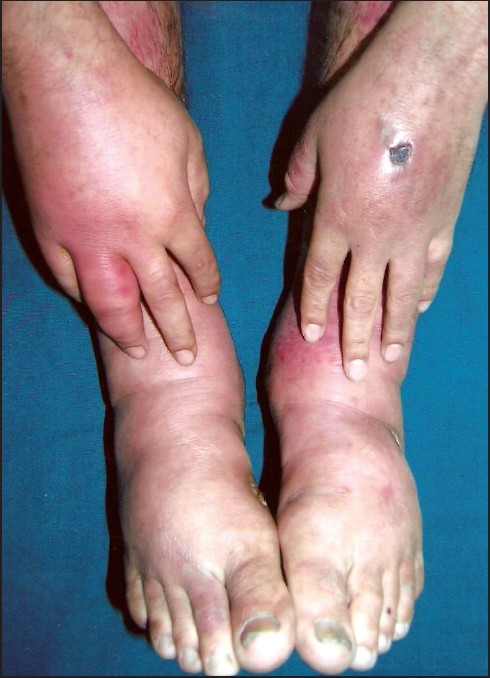Translate this page into:
Cutaneous complications of pentazocine abuse
2 Department of Psychiatry, Uttaranchal Forest Hospital Trust and Medical College, Haldwani, Nainital, India
Correspondence Address:
Saurabh Agarwal
Department of Dermatology and Venereology, UFHT and Medical College Haldwani, (Nainital), Uttarakhand-263139
India
| How to cite this article: Agarwal S, Trivedi M. Cutaneous complications of pentazocine abuse. Indian J Dermatol Venereol Leprol 2007;73:280 |
 |
| Figure 2: Ulcer with necrotic eschar and nonpitting edema of both hands and feet (Puffy-hand syndrome) |
 |
| Figure 2: Ulcer with necrotic eschar and nonpitting edema of both hands and feet (Puffy-hand syndrome) |
 |
| Figure 1: Ulcers/scars on both legs and feet |
 |
| Figure 1: Ulcers/scars on both legs and feet |
Sir,
We read with interest the report by De et al. on ′Pentazocine-induced leg ulcers and fibrous papules′. [1] Recently we also observed a similar case which we are reporting here. A 27 -year-old male, a paramedical worker by profession, presented with a history of ulcers over the extremities for the last two years. The patient himself admitted pentazocine and alcohol abuse over the last two and half years. Initially he used to inject in the veins but later on he started using subcutaneous injection, as it became difficult to inject in the veins. Within a few days of injecting pentazocine, he used to develop nodules, which would burst open discharging blood-stained or oily fluid, followed by the formation of ulcers.
On cutaneous examination, he had multiple, punched-out deep ulcers [Figure - 1] over the dorsa of the hands, legs and feet. These ulcers were irregular in shape, 1-2 cm. in size, surrounded by hyperpigmentation and most of them had yellowish exudates at their bases. Necrotic eschar was present at the floor of the ulcer over the dorsum of the hand [Figure - 2]. There was no discomfort due to these ulcers. The adjacent skin was erythematous, indurated and edematous and at places, depressed scars were present within the indurated areas. Small atrophic scars with underlying induration were present at sites of venous access like cubital fossa, lateral borders of wrists, dorsa of hands and feet. The patient also had nonpitting edema of hands and feet, which is also called as puffy-hand syndrome, usually seen in opioid addicts [Figure - 2]. There was difficulty in peripheral vein access. On psychiatric evaluation, no underlying psychiatric abnormality was found. He was premorbidly adjusted and was handling his responsibilities adequately. Routine hematological and biochemical tests were within normal limits. Screening for Hepatitis B virus (HBV), Hepatitis C virus (HCV), human immunodeficiency virus (HIV) and antinuclear antibodies (ANA) was negative. Histopathology showed nonspecific features. The patient was treated conservatively along with psychiatric consultation and counseling.
Pentazocine was introduced in 1967 as a "nonnarcotic, nonaddicting" analgesic. However, the abuse potential of this medication was soon recognized and cutaneous and muscular complications of pentazocine abuse have been reported. [2],[3],[4],[5] Prasad et al. [6] have described the diagnostic pointers for pentazocine-induced ulcers which are irregular shaped, deep ulcers with black eschars and surrounding induration, halo of hyperpigmentation, ulcers/nodules/scars along superficial veins, woody induration, needle pricks / thrombophlebitis, puffy-hand syndrome, difficulty in venous access, fibrous myopathy, apparent indifference of the patient (lack of discomfort), past history of a chronic painful medical condition, prior iatrogenic administration of pentazocine, patients associated with medical profession (relatively easier access to the drugs). Our present case also had most of the above-mentioned features except fibrous myopathy and past history of a chronic painful medical condition. The exact pathogenesis of cutaneous complications of pentazocine is not known. It has been suggested that if not rapidly absorbed, pentazocine may get precipitated in the slightly alkaline pH of extracellular fluid. The precipitated crystals may then initiate a chronic inflammatory response. [7] Repeated injections probably lead to sclerosis of the veins leading to difficulty in gaining access to peripheral veins. The puffy-hand syndrome, i.e., nonpitting edema of the dorsa of the hands sparing the fingers, can occur with any injectable opioid abuse. Occlusion of venous or lymphatic drainage or both, may be the cause of the edema.
The definitive evidence of pentazocine abuse, i.e., the history and its presence in the urine, may not be present in all the cases. In such a scenario, the clinical features are of great importance. Recognition of the condition will prevent misdirected investigations and treatment.
| 1. |
De D, Dogra s, Kanwar AJ. Pentazocine-induced leg ulcers and fibrous papules. Indian J Dermatol Venereol Leprol 2007;73:112-3.
[Google Scholar]
|
| 2. |
Palestine RF, Millns JL, Spigel GT, Schroeter AL. Skin manifestations of pentazocine abuse. J Am Acad Dermatol 1980;2:47-55.
[Google Scholar]
|
| 3. |
Mann RJ, Gostelow BE, Meacock DJ, Kennedy CT. Pentazocine ulcers. J R Soc Med 1982;75:903-5.
[Google Scholar]
|
| 4. |
Jain A, Bhattacharya SN, Singhal A, Baruah MC, Bhatia A. Pentazocine induced widespread cutaneous and myo-fibrosis. J Dermatol 1999;26:368-70.
[Google Scholar]
|
| 5. |
Kim HA, Song YW. Polymyositis developing after prolonged injections of pentazocine. J Rheumatol 1996;23:1644-6.
[Google Scholar]
|
| 6. |
Prasad HR, Khaitan BK, Ramam M, Sharma VK, Pandhi RK, Agarwal S, et al. Diagnostic clinical features of pentazocine-induced ulcers. Int J Dermatol 2005;44:910-5.
[Google Scholar]
|
| 7. |
Schlicher JE, Zuehlke RL, Lynch PJ. Local changes at site of pentazocine injection. Arch Dermatol 1971;104:90-1.
[Google Scholar]
|
Fulltext Views
2,691
PDF downloads
3,420





